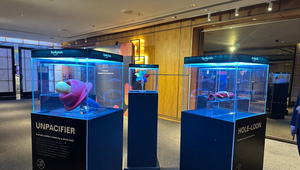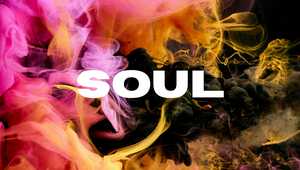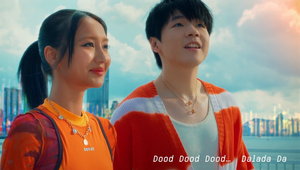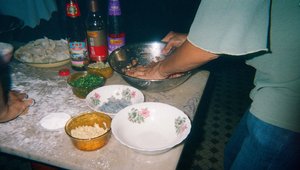
5 Minutes with… Andreas Krasser

CEO at DDB Hong Kong, Andreas Krasser is widely respected throughout the industry, consistently earning recognition at local, regional and international award shows. As well as a string of Cannes Lions, Effies and WARC Awards under his belt, Andreas has been recognised in Campaign Asia’s 40 under 40 list in 2019, and has twice been named Campaign Asia’s Planner of the Year.
His diverse portfolio includes work for renowned brands such as McDonald's, Volkswagen, MARS, PepsiCo, hotels.com, and BlackRock, across various markets like Korea, Hong Kong, China, Thailand, Singapore, and the Philippines. He believes that this, paired with his intercultural upbringing, is the key to his unique perspective across the Asian market.
In this interview with LBB’s Sunna Coleman, Andreas opens up about what being both an insider and outsider has taught him, and why universal truths need hyper-local nuances.
LBB> You're fluent in German, English, and Korean. How has your multilingualism influenced your approach to communication, both within your team and in reaching diverse audiences?
Andreas> Growing up as half Korean and half Austrian, I’ve always had to navigate between cultures. While languages played a role in this, what shaped me most was learning to see the world through different cultural lenses. Language is a starting point – it opens doors to understanding – but it’s really about developing intercultural empathy that transforms communication.
I believe that the duality of being both an insider and outsider in different contexts taught me how to adapt, listen, and find common ground early on. Within a team, this manifests as an ability to bridge perspectives and create an environment where people feel heard, regardless of their background. For diverse audiences, it’s about respecting the cultural context they bring to the conversation and tailoring the message in a way that resonates emotionally, not just linguistically.
For example, in professional settings, some cultures value directness, while others prioritise harmony, subtlety, and saving face. Navigating these dynamics has taught me to adapt my communication style – not by changing who I am, but by being mindful of how messages will be received by others.
Ultimately, cross–cultural communication is less about the mechanics of language and more about cultivating curiosity, adaptability, and respect. It’s about making the effort to put yourself in someone else’s shoes – whether through their words, their values, or their unspoken cues. That’s what shapes how you connect with people and craft meaningful narratives, both in teams and in advertising.
LBB> As a published author in cross–cultural consumer research, what emerging trends or shifts in consumer behaviour do you find most intriguing or challenging for marketers today?
Andreas> One of the most intriguing and challenging shifts I observe is the growing tension between globalisation and hyper–localisation. On one hand, global platforms are shaping a shared popular culture in the social media space, where trends spread across borders with incredible speed. Some even say it’s at the heart of a cultural flattening we’re experiencing across the globe.
On the other hand, there’s a parallel rise in consumers seeking hyper–local relevance that matches their unique cultural identities and values. In many markets here in Asia, we see a lot of nostalgia for local foods, memorabilia, and traditions, not just among older consumers but also younger ones, who long for times they weren’t even born into.
For marketers who want to reach multiple audiences across Asian countries, this creates a delicate balancing act. We need to craft campaigns that embody universal truths but are also flexible enough to adapt to hyper–local nuances. It’s definitely not about simply translating a message; it’s about transforming it to fit different cultural contexts without losing its core essence.
LBB> With your experience in different regions, including North Asia and Greater China, how do you approach creating campaigns that resonate across diverse markets, and what role does cultural sensitivity play in your strategic planning?
Andreas> Creating campaigns that span diverse markets starts with a foundation of respect and curiosity. Cultural sensitivity isn’t just a checklist of dos and don’ts – it’s about deeply understanding the values, beliefs, and emotions that drive people in different parts of the world.
For campaigns that are supposed to resonate across multiple markets, I usually start with the hunt for shared human truths, universal insights that transcend borders. Then it’s about localising the tone, visuals, and execution to reflect local nuances. For example, while a core concept might work across markets, the way it’s expressed visually or emotionally will often need to shift to align with cultural norms and expectations.
Being able to tap into diverse teams throughout the entire process is key: a variety of perspectives ensures we challenge our assumptions and avoid falling into the trap of cultural stereotypes. Another crucial component is co–creating and sensitivity–checking with local talent, not just as a formality, but as a way of embedding authenticity into the work.
Ultimately, cultural sensitivity is about being humble enough to listen and learn. It’s about recognising that creativity thrives when we embrace and leverage differences while also understanding what connects us all.
LBB> Can you share a project where navigating cultural nuances significantly impacted the success of a campaign, and how did you approach this challenge?
Andreas> One project that comes to mind involved developing a regional campaign for insurance brand, FWD, which needed to resonate across several diverse markets in Asia, including Hong Kong, Thailand, the Philippines, Vietnam, and Indonesia. The core concept of the ‘Everyday Heroes’ campaign celebrated the courage it takes to make small but impactful decisions in everyday life — a universal insight that required local adaptation to feel authentic in each market.
To navigate these cultural nuances, we conducted extensive research to understand how different audiences interpreted themes like bravery and confidence. In some markets, for instance, the emphasis leaned toward family–oriented decisions, reflecting collectivist values, while in others, personal independence and self–expression were more resonant themes.
Our creative executions were tailored to reflect these differences while staying true to the overarching message. This approach ensured the campaign maintained a cohesive regional feel while still connecting with local audiences. Collaboration with local client teams, strategists, and creatives was instrumental in achieving this balance, as they brought essential cultural perspectives and insights to the table.
The campaign ultimately succeeded because it embraced both the shared human truth at its core and the unique ways different cultures expressed that truth. For me, this experience reinforced that cultural nuance is not a challenge to overcome, nor an excuse to dismiss broadly appealing concepts — it’s an opportunity to make those concepts richer and even more meaningful.
LBB> Having been listed among Campaign Asia's 40 under 40 in 2019, how do you see the role of young talent in shaping the future of the advertising and marketing industry, and what advice would you give to emerging professionals?
Andreas> Young talent obviously is the lifeblood of our industry. They bring fresh perspectives and infuse new energy into creative processes. What excites me most about the next generation is their natural fluency in cultural diversity and tech literacy. They’re growing up in a world where boundaries – whether cultural, technological or creative – are more fluid than ever, which uniquely positions them to drive the industry forward.
My advice to emerging professionals is twofold:
1. Value collaboration over ego. Advertising is a team sport. The ability to work well with others, particularly those from different backgrounds, is a superpower in our increasingly interconnected world. Listen more than you speak, and don’t be afraid to admit what you don’t know – it’s how you’ll grow.
2. Embrace a multicultural mindset. Even if your background isn’t multicultural, actively seek out diverse perspectives and learn to see the world through multiple lenses. The most innovative ideas often come from blending different viewpoints. It’s not just a survival skill in today’s industry – it’s a creative edge.
By staying curious, open, and collaborative, young talent has the power to shape a more inclusive, innovative, and impactful future for our industry.















